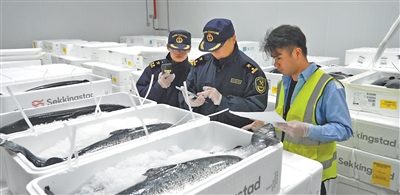




- BRNN
- BRI News
- BRNN News
- Database
Official Documents Polices and Regulations
Inter-government Documents International Cooperation BRI Countries
Business Guide Economic Data BRI Data
Trade
Investment Projects Latest projects
Cases - Content Pool

Customs staff members inspect imported chilled aquatic products at the cold storage facility of International Cargo Centre Shenzhen (ICCS) in Shenzhen, south China's Guangdong Province. (Photo/Ye Junchao)
It's peak season for seafood, and getting these delicacies fresh to dining tables requires a sophisticated cold-chain process. The journey involves packing at workshops, pre-cooling at cold storage facilities and refrigerated transport. Specialized equipment, ranging from cold storage warehouses to refrigerated trucks, ensures products remain fresh throughout the supply chain.
At 4 a.m., farmers harvest hairy crabs at the farm of an agricultural technology company in Yong'an town, Kenli district, Dongying city, east China's Shandong Province. Within 12 hours or less, the crabs will be delivered nationwide via cold-chain logistics.
In the company's packing workshop, workers sort the crabs. "We've built a one-stop cold-chain logistics distribution warehouse. Before shipping, crabs are pre-cooled for six to eight hours," said Wang Yingze, general manager of the company.
At the cold-chain logistics distribution warehouse, vehicles from China Post, SF Express, JD.com, and others arrive and depart. "During peak season, daily shipments can reach nearly 20,000 orders, weighing 20,000 to 25,000 kilograms," Wang said.
Cold-chain logistics trucks transport the crabs to China Post's local logistics hub, where they are sorted and reloaded for nationwide delivery.
"We provide same-day delivery within the city, next-morning delivery within the province and next-day delivery to 45 cities. All shipments are sent via direct cold-chain routes with no transfers, ensuring the crabs arrive in peak condition," said Lu Shiyuan, deputy general manager of China Post's branch in Kenli district.
According to the China Federation of Logistics and Purchasing, China's food cold-chain logistics demand reached 192 million tonnes in the first half of this year, up 4.35 percent year on year. The food cold-chain logistics sector generated 280 billion yuan ($39 billion) in revenue during the first half of the year, representing a 3.84 percent year-on-year increase.
Driven by government planning and market demand, cold storage facilities are expanding and upgrading with smart technology, fueling investment and steady market growth.
On Oct. 8, a cargo plane landed at Shenzhen Bao'an International Airport in Shenzhen, south China's Guangdong Province. About 4 tonnes of Atlantic salmon were unloaded and transferred by cold-chain logistics trucks to the airport's international cargo cold storage facility.
"Imported chilled aquatic products can now hit the market the same day they arrive," said Tan Weiping, deputy general manager of International Cargo Centre Shenzhen (ICCS). The efficient operations of cold storage facilities and streamlined customs clearance make the business smoother than ever.
In the first nine months of this year, ICCS's cold storage facility handled 31,000 tonnes of fresh seafood, fruits and other fresh products, increasing 36 percent year on year. The products accounted for over 48 percent of cargo arriving at the port during the same period.
Across the country, investment in cold storage facilities reached 22.31 billion yuan in the first half of the year, up 7.67 percent year on year. By the end of June, total public food cold storage capacity in major consumer markets had risen 6.12 percent year on year to 260 million cubic meters.
With the rapid growth of fresh-food e-commerce and chain restaurants, urban delivery demand is soaring, boosting sales of light refrigerated trucks. Policy incentives and expanded road access have also driven a surge in new-energy refrigerated trucks.
According to the China Federation of Logistics and Purchasing, 29,474 refrigerated trucks were sold in the first half of the year, up 18.19 percent year on year.

Tel:86-10-65363107, 86-10-65368220, 86-10-65363106